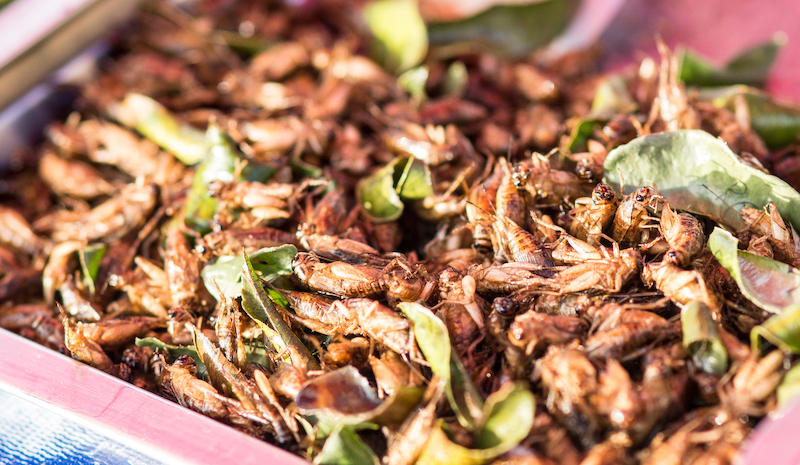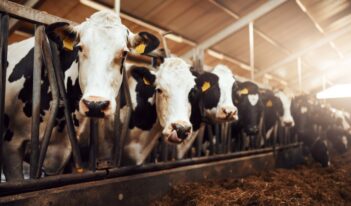
Scholar argues FDA should regulate insects as food to help address food insecurity.
How would you react if you were dining out and found a cricket in your soup? Would you feel the same if cricket soup were on the menu?
In a recent article, Marie Boyd of the University of South Carolina School of Law argues that although eating insects is not widely accepted in the United States—and may even be considered repugnant—the practice should, in fact, be embraced for its potential to mitigate food insecurities worldwide. Boyd calls on the U.S. Food and Drug Administration (FDA) to lead by example in changing cultural norms around insect consumption by reversing its regulatory approach to insects in food, from categorically treating them as “filth” to supporting their safe, intentional use.
Boyd stresses that food insecurity—a “household-level economic and social condition of limited or uncertain access to adequate food,” as defined by the U.S. Department of Agriculture—will only continue to intensify as food production fails to keep pace with rapid population growth. Boyd theorizes that insect consumption can help enhance adequate food access for several reasons.
First, the sheer abundance of insects worldwide makes them a plentiful food option, with approximately 80 million species in existence and approximately 2,000 species already known to be edible.
Second, insects can provide high nutritional value, varying by species and other factors. They may, according to the Food and Agricultural Organization of the United Nations, “represent good sources of proteins, fats, minerals, vitamins, and energy”—even perhaps surpassing meat’s nutritional value “in situations of undernutrition.”
Third, insects can serve as more environmentally friendly alternatives to traditional livestock. Insects release less greenhouse gas, require comparatively less feed, and do not necessarily require land use for their production, unlike livestock. For this reason, developing insects as food sources can contribute to making food production more sustainable in the long-term.
To take advantage of insects’ potential for mitigating food insecurities, changing public perceptions will be key, Boyd argues. She notes that many countries already accept insect consumption—and that Western cultures are just beginning to look more favorably on insects thanks to the rise of food trends like sustainability and healthy eating.
Boyd also concedes that FDA has made some effort in informally condoning insect consumption, for instance in speeches given by its employees. She argues, however, that the plethora of FDA regulation treating insects as food “defects” effectively nullifies any positive treatment the agency has advanced. Boyd maintains, moreover, that, given FDA’s global influence in food policy and culture, insect consumption will not gain meaningful traction without the agency’s specific legal endorsement of insects as “food.”
Boyd writes that FDA’s definition of food is already broad enough to accommodate insect consumption under the agency’s regulatory framework. The Federal Food and Drug Act (FDCA), which defines food for the agency, states “articles used for food or drink for man” and “articles used for components of any such article” qualify as food. Currently, FDA considers insects to violate the FDCA by classifying them not as food, but as “filth,” which “adulterates” food or renders it unsafe for consumption. The agency only permits insects in food under this framework if and when their presence is considered to be inevitable at low levels or in circumstances where insects serve recognized purposes, such as predaceous species controlling other insect populations in raw whole grain.
Boyd does not pretend FDA’s concerns about insect consumption are entirely baseless—after all, insects can carry disease or otherwise may be toxic to consumers. But she does argue that a categorical bar on insects is unnecessary if not deleterious. If, instead, insect-based foods were admitted within the regulatory framework for “food,” she argues, FDA could appropriately monitor the insects themselves for adulterating substances, thus still allowing consumers to reap the benefits of eating clean insect products.
Regulating insects as food, Boyd writes, would require that they be “raised, produced, and processed using good sanitation practices and controls.” Moreover, treating them as food would encourage firms’ research and development into improving the safety of insect production. In addition, regulatory oversight by FDA would help ensure that insect-based foods are properly labeled, which could be particularly significant in situations where beneficial insects may be allergenic and should be highlighted on labels like other common allergens such as dairy, wheat, and tree nuts.
Still, recognizing that some insects can and should still qualify as “filth” in the food context, Boyd suggests that FDA use intent to guide the division between “filth” and “food” going forward. If firms intend to produce insects for consumption—such as by labeling their products to include insects as ingredients—then insects should be regulated as food and tested for adulteration. If not, FDA should properly consider them to be filth.
Boyd notes this approach is not without challenges. FDA’s definition of food does not actually incorporate “intent,” nor do courts support intent as a factor in determining whether something is “food,” due to the ease with which manufacturers can avoid regulation of their food products by claiming their products are not intended for consumption.
Boyd nonetheless argues that intent is a viable means of demarcation, due in part to its successful use in other classifications under the FDCA. Boyd emphasizes that FDA need not rely on the subjective intent of the manufacturer, as courts suggest, but rather could feasibly consider the “circumstances surrounding the distribution of the article.” These circumstances may include “labeling claims, advertising matter, or oral or written statements by such persons or their representatives.”
Ultimately, regardless of whether “intent” is the best vehicle for appropriate FDA regulation of insects as food or not, Boyd entreats the federal government to acknowledge the many benefits insect consumption can provide in the face of acute food insecurities worldwide and increasingly in the United States.



